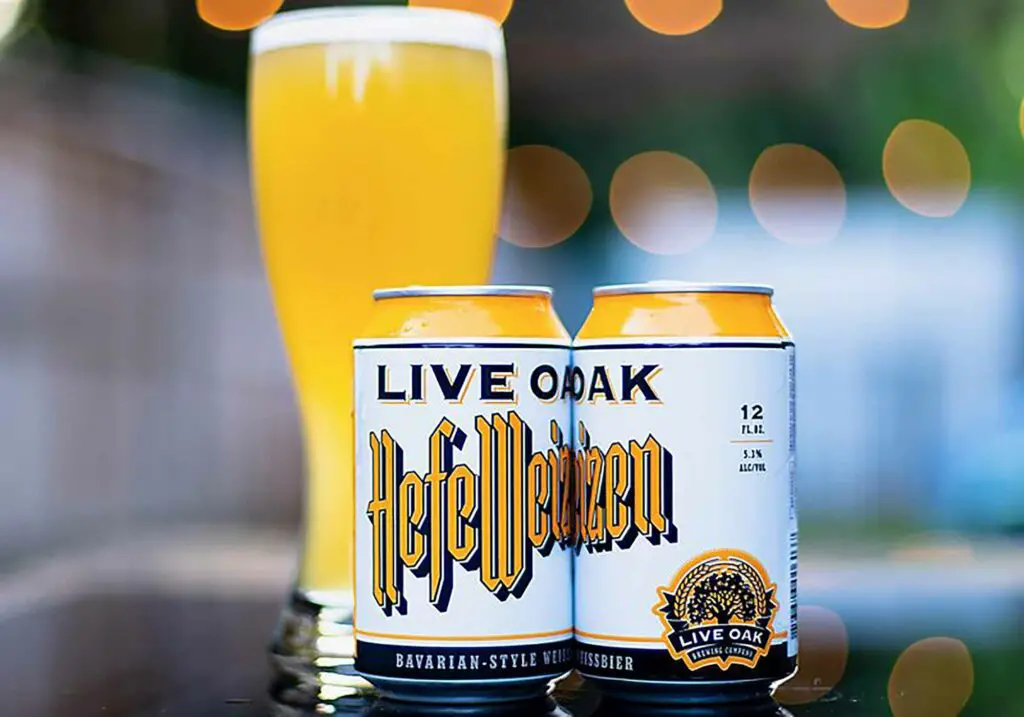Hefeweizen is a popular German wheat beer known for its fruity and spicy notes and cloudy appearance due to the presence of yeast in suspension.
If you enjoy Hefeweizen, you might also enjoy similar beers such as Belgian Witbier, American Wheat Beer, Saison, Dunkelweizen, and Berliner Weisse.
Belgian Witbier is spiced with coriander and orange peel, giving it a fruity and spicy character like Hefeweizen.
American Wheat Beer is a crisp, refreshing beer with mild fruity and spicy notes.
At the same time, Saison is a French/Belgian farmhouse ale often brewed with wheat and has a fruity and spicy character similar to Hefeweizen.
Is Hefeweizen an Ale or Lager?
Hefeweizen is a type of ale.
It is a German wheat beer brewed with a significant proportion of wheat in addition to malted barley and is typically fermented with a top-fermenting yeast strain.
Wheat makes Hefeweizen its characteristic cloudy appearance, and the yeast strain used in fermentation contributes to its distinctive fruity and spicy flavor profile.
Lagers are fermented with a bottom-fermenting yeast strain at cooler temperatures and are typically brewed with a more significant proportion of malted barley.
Examples of lagers include Pilsner, Munich Helles, and Oktoberfest beers.
Is Hefeweizen Similar to Pilsner?
No, Hefeweizen is not similar to Pilsner. Different beer styles have different ingredients, brewing processes, and flavor profile differences.
Hefeweizen is a German wheat beer with a fruity and spicy flavor profile, brewed with a significant proportion of wheat and fermented with a top-fermenting yeast strain.
Conversely, Pilsner is a Czech lager with a herbal and spicy flavor profile, brewed with a large proportion of malted barley and hopped with Saaz hops.
It has a crisp, clean, and refreshing taste, with a light body and a clear, pale golden color.
Is Belgian White The Same as Hefeweizen?
Belgian White and Hefeweizen are similar beer styles but not precisely the same.
Belgian White, known as Witbier, is a Belgian-style wheat beer brewed with coriander and orange peel, giving it a spicy and citrusy flavor profile.
On the other hand, Hefeweizen is a German wheat beer brewed with a significant proportion of wheat and fermented with a top-fermenting yeast strain, giving it a distinctly fruity and spicy flavor.
Is Blue Moon a Hefeweizen Beer?
No, Blue Moon is not a Hefeweizen beer. Blue Moon is a Belgian-style Witbier that is brewed with coriander and orange peel, giving it a spicy and citrusy flavor profile.
While Blue Moon may share some similarities with Hefeweizen, such as its cloudy appearance and wheat base, it has a distinct flavor profile that is different from Hefeweizen.
What is a Substitute For Hefeweizen?
If you’re looking for a substitute for Hefeweizen, there are several other types of wheat beers that you might enjoy.
For example, Belgian Witbier, or White Ale, is a refreshing wheat beer with a hazy appearance and a light, citrusy flavor profile to Hefeweizen.
Another option is American Wheat Beer, a less traditional but still tasty wheat beer that typically has a more hoppy flavor and aroma than Hefeweizen.
If you’re looking for a non-wheat beer option with a similar light, refreshing character, consider trying a German or Czech Pilsner.
Ultimately, the best substitute for Hefeweizen will depend on your taste preferences, but these options are great.
What Kind of Malt for Hefeweizen?
Hefeweizen is a wheat beer typically made with malted wheat and barley.
The exact proportions of wheat to barley can vary depending on the recipe, but a typical Hefeweizen might use a malt bill that is 50% malted wheat and 50% malted barley.
However, the wheat contributes to the beer’s hazy appearance and light, refreshing flavor profile, while the barley provides body and sweetness.
In terms of specific types of malt, many Hefeweizen recipes call for Pilsner malt, which is a light-colored base malt that contributes a clean, crisp flavor to the beer.
Some recipes may also use small amounts of specialty malts, such as Munich malt or Vienna malt, to add complexity and flavor to the finished beer.
What Flavors Describe Hefeweizen?
Hefeweizen is a type of wheat beer that is known for its distinctive flavor profile.
Some flavors commonly associated with Hefeweizen include notes of banana, clove, and sometimes even a hint of vanilla.
These flavors result from the yeast used to ferment the beer, which produces esters and phenols that give the beer its characteristic aroma and flavor.
Additionally, Hefeweizen typically has a light, refreshing taste with a slightly sweet, bready character from the malted wheat and barley used to brew the beer. The carbonation is usually high, which gives it a crisp, effervescent mouthfeel.
Overall, Hefeweizen is a flavorful and refreshing beer that is perfect for warm weather or as a complement to spicy or savory foods.
Do All Hefeweizen Taste Like Banana?
While banana is a common flavor note in many Hefeweizen beers, it’s not a universal style characteristic.
The banana flavor in Hefeweizen results from the specific yeast strains used during fermentation, which can produce esters that give the beer a fruity, sometimes banana-like aroma and taste.
Not all Hefeweizen beers will have a prominent banana flavor. Other esters and phenols produced by the yeast, such as clove or vanilla, may be more pronounced in some beers. Additionally, using different malts, hops, or brewing techniques can influence Hefeweizen’s flavour profile and may result in a less banana-forward beer.
Is Hefeweizen a Dark Beer?
No, Hefeweizen is not a dark beer. It’s typically quite the opposite. Hefeweizen is a type of wheat beer that is known for its hazy, pale-yellow appearance.
This is because Hefeweizen is brewed with a significant portion of wheat in addition to malted barley, which gives the beer its light color and refreshing taste. While the exact color of Hefeweizen can vary somewhat depending on the specific recipe and brewing techniques, it is generally considered a light-colored beer.
